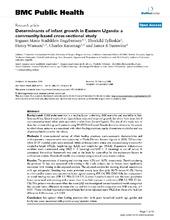| dc.description.abstract | Background: Child under-nutrition is a leading factor underlying child mortality and morbidity in Sub- Saharan Africa. Several studies from Uganda have reported impaired growth, but there have been few if any community-based infant anthropometric studies from Eastern Uganda. The aim of this study was to describe current infant growth patterns using WHO Child Growth Standards and to determine the extent to which these patterns are associated with infant feeding practices, equity dimensions, morbidity and use of primary health care for the infants. Methods: A cross-sectional survey of infant feeding practices, socio-economic characteristics and anthropometric measurements was conducted in Mbale District, Eastern Uganda in 2003; 723 motherinfant (0–11 months) pairs were analysed. Infant anthropometric status was assessed using z-scores for weight-for-length (WLZ), length-for-age (LAZ) and weight-for-age (WAZ). Dependent dichotomous variables were constructed using WLZ < -2 (wasting) and LAZ < -2 (stunting) as cut-off values. A conceptual hierarchical framework was used as the basis for controlling for the explanatory factors in multivariate analysis. Household wealth was assessed using principal components analysis. Results: The prevalences of wasting and stunting were 4.2% and 16.7%, respectively. Diarrhoea during the previous 14 days was associated with wasting in the crude analysis, but no factors were significantly associated with wasting in the adjusted analysis. The adjusted analysis for stunting showed associations with age and gender. Stunting was more prevalent among boys than girls, 58.7% versus 41.3%. Having brothers and/or sisters was a protective factor against stunting (OR 0.4, 95% CI 0.2–0.8), but replacement or mixed feeding was not (OR 2.7, 95% CI 1.0–7.1). Lowest household wealth was the most prominent factor associated with stunting with a more than three-fold increase in odds ratio (OR 3.5, 95% CI 1.6– 7.8). This pattern was also seen when the mean LAZ was investigated across household wealth categories: the adjusted mean difference between the top and the bottom wealth categories was 0.58 z-scores, p < 0.001. Those who had received pre-lacteal feeds had lower adjusted mean WLZ than those who had not: difference 0.20 z-scores, p = 0.023. Conclusion: Sub-optimal infant feeding practices after birth, poor household wealth, age, gender and family size were associated with growth among Ugandan infants. | en_US |

